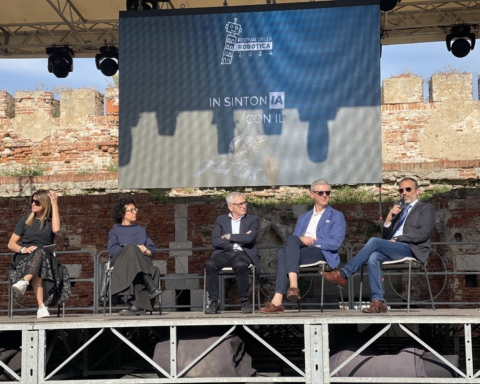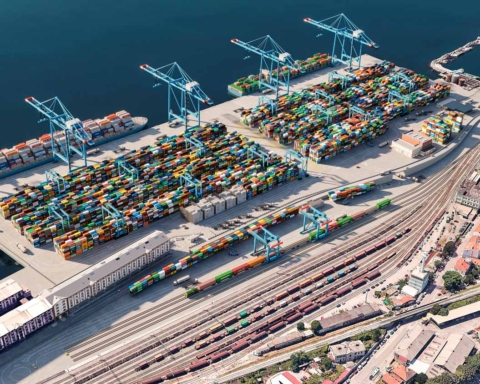Livorno will be the first Italian port – and one of the first in Europe – to experiment with autonomous navigation.
Within the framework of the 5GMASS EU project, funded by the European Space Agency (ESA) and carried out by a consortium of companies and research bodies (TIM; CNIT; FlySight, CETENA and Grimaldi), Livorno port has been chosen as the ideal test bed for monitoring progress in the automation of logistics processes and ship-port connections.
The reason for this choice is to be found in the success over the last few years of the experiments conducted in the port by Ericsson and CNIT in the field of 5G. The latest-generation mobile technology was launched in the port in 2018, thanks to some cells being set up. Today such progress has been made as to allow Livorno to take on the role of a forerunner in defining port information models focused not only on the integration between the road and the port network, but also between the port network itself and shipping lines.
The next step will therefore be to use advanced digital connectivity to communicate with a vessel and, in this case, with a modern Ro-Ro ship, from Grimaldi’s ECO fleet, which will be equipped with additional sensors and integrated into the port’s 5G network.
This was the starting point for the workshop organized this morning by the Port Network Authority at the Grand Hotel Palazzo in Livorno. Everyone involved in the project was present, including, first and foremost, the Coast Guard, responsible for supervising the experiments that will be conducted as part of 5GMass, represented by the head of the Maritime Ship Safety Department at the Italian Coastguard Headquarters, Rear Admiral Luigi Giardino.
After the opening institutional greetings by the president of the North Tyrrhenian Port Network Authority, Luciano Guerrieri, and Admiral Gaetano Angora, head of Tuscany Maritime Directorate, followed by Rear Admiral Giardino’s introduction on the challenges awaiting the maritime/port sector not only from a technological but also from a regulatory point of view, it was the director of the CNIT laboratory at the Port of Livorno, Paolo Pagano, who illustrated the importance of the 5G Mass project: “The Port of Livorno has a unique national background and proven experience in the application of IOT to logistics processes and operations on land,” he said, adding how the collaboration between TIM and Ericsson at national level in building a robust ecosystem now allows ports to maximize the potential of fifth-generation cellular technology
TIM will be the one to install the new private 5G network in Livorno port, capable of travelling at a connection speed of 10 gigabytes per second: “It is as if the port had a cannon able to shoot optical fibre directly into the sea. With it we will be able to communicate with ships, at a level of integration that gets increasingly higher in proportion to the degree of autonomy on board the vessel,” Mr. Pagano added.
During the trials, Grimaldi’s eco-ship will receive strategic information of various kinds directly from the Remote-Control Station, already installed at the CNIT headquarters in Livorno at the Customs House. This information includes access to the weather conditions dataset and evaluation data on the feasibility of entering the port. Harbour pilots will also be involved, as they have a fundamental role in maintaining safe conditions for ships navigating inside the port.
Thanks to this experiment, which is set to start before the end of summer, Livorno will be able to present itself as a pioneer in the application of new mobile technology to ship/terminal operations, as Paolo Vannuzzi Innocenti (TIM) and Riccardo Mascolo (Ericcsson) pointed out during their speeches.
The benefits of the Maritime Autonomous Surface Ship (MASS) were listed by Grimaldi’s manager Cosimo Cervicato: “Autonomous navigation increases the safety standards of a ship’s berthing manoeuvres and also helps shorten the time it takes to enter and leave a port,” he said. “If we were able to reduce them by 15 minutes, we could go as far as reducing the speed of navigation, with a significant reduction in Co2 emissions.”
The head of the European Space Agency (ESA), Roberta Mugellesi, also spoke about environmental sustainability. In particular, she focused on the strategic importance of the agreement stipulated between ESA and the Italian Coastguard headquarters in 2022 promoting a collaboration to enhance the use of space applications aimed at developing sustainable innovation for the marine ecosystem and merchant shipping.
Port Network Authority managing director, Matteo Paroli, had the task of concluding the workshop: “Everything we have seen looks like science fiction but autonomous navigation is already a reality. The benefits are many but so are the challenges,” he said.
“There are many issues concerning smart-ships. They include responsibility profiles, for instance, and the use of technical-nautical services and rescue. Moreover, they pose new problems in terms of captain and crew. We will have to review national and international legislation on maritime law to adapt to the changes taking place. Technology is moving fast and the legal world must manage to go at the same speed if we do not want certain regulatory limitations to force us to abandon a technological, study and analysis capacity that currently distinguishes us at European level.”
Translation by Giles Foster




